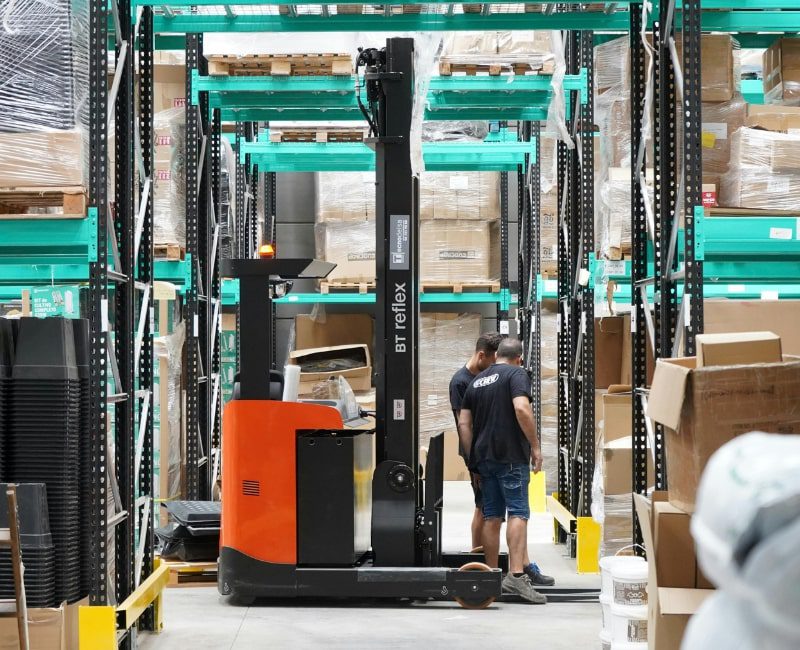Did you know that poor inventory management caused businesses to lose up to 11% of their annual revenue? That’s a hefty price to pay for inefficient logistics.
However, modern inventory management has evolved far beyond simple spreadsheets and manual tracking. It’s now a sophisticated blend of technology, data analysis, and strategic partnerships, all working together to optimize stock levels and streamline the entire supply chain.
Effective inventory management is a necessity for survival and growth. Businesses face numerous challenges, from accurately forecasting demand and managing complex supply chains to minimizing storage costs and adapting to fluctuating market conditions.
Striking the right balance between having enough inventory to meet customer needs and avoiding excess stock that ties up valuable capital is a delicate balancing act. Let’s dive into the key components of modern inventory management, exploring how businesses can leverage technology, data, and strategic partnerships to optimize their inventory processes and gain a competitive edge.
Key Components of Modern Inventory Management
Modern inventory management is a multifaceted process. It relies on several key components working in concert to achieve optimal results, from minimizing costs and maximizing efficiency to enhancing customer satisfaction and driving profitability.

Technology Integration
Technology is the backbone of modern inventory management. Several systems play crucial roles, automating processes, providing real-time visibility, and enabling data-driven decision-making.
- Inventory Management Software (IMS): IMS provides real-time tracking of inventory levels, automates reporting, and helps manage stock movements. It’s the central hub for inventory data.
- Warehouse Management Systems (WMS): WMS optimizes warehouse operations by streamlining receiving, putaway, picking, and shipping processes. They improve efficiency and reduce errors within the warehouse itself.
- Enterprise Resource Planning (ERP) Systems: ERP systems integrate inventory data across the entire business, connecting it with other departments like finance and sales. This provides a holistic view of the business.
- Cloud-based Solutions: Cloud-based solutions offer accessibility from anywhere, scalability to meet growing needs, and reduced IT infrastructure costs. They’re essential for modern, agile businesses.
- API Integrations: Seamless data exchange between different systems is crucial. API integrations allow various software platforms to “talk” to each other, ensuring data consistency and accuracy.
Data-Driven Decision Making
Data is essential in effective inventory management. Companies that use data analytics for inventory management decisions see a 20% reduction in overall costs. Analyzing data provides valuable insights that drive strategic decisions and optimize inventory performance.
- Real-time Visibility: Up-to-the-minute inventory information is essential for making informed decisions. Knowing what you have, where it is, and what’s coming is paramount.
- Demand Forecasting: Data analytics helps predict future demand, allowing businesses to proactively adjust inventory levels and avoid stockouts or overstocking.
- Performance Metrics: Key performance indicators (KPIs) like inventory turnover, stockout rates, and carrying costs provide insights into inventory performance and identify areas for improvement.
- Reporting and Analytics: Generating insightful reports enables businesses to make informed decisions about inventory strategy, pricing, and purchasing.
Optimized Warehouse Operations
Efficient warehouse operations are fundamental to successful inventory management. A well-organized and optimized warehouse ensures smooth and efficient inventory flow.
- Warehouse Layout and Design: Efficient space utilization and optimized workflows within the warehouse are essential for minimizing costs and maximizing productivity.
- Inventory Control Techniques: Methods like ABC analysis (categorizing inventory based on value), cycle counting (regularly counting small portions of inventory), and FIFO/LIFO (First-In, First-Out/Last-In, First-Out inventory valuation) help maintain accurate stock levels.
- Automation and Robotics: Technologies, like automated guided vehicles (AGVs) and robotic picking systems, automate tasks, improve accuracy, and reduce labor costs. In fact, 78% of eCommerce companies plan to invest in inventory management automation to stay competitive.
- Cross-docking and Just-in-Time (JIT) Inventory: Cross-docking eliminates the need for storage by directly transferring goods from inbound to outbound shipments. JIT inventory minimizes storage costs by receiving goods only when needed.
Supply Chain Collaboration
Strong relationships and information sharing across the supply chain are critical. Collaboration with suppliers and partners ensures smooth and efficient inventory flow.
- Supplier Relationships: Strong communication and collaboration with suppliers ensure timely deliveries and help mitigate supply chain disruptions.
- 3PL Partnerships: Outsourcing inventory management to a 3PL provider offers access to specialized expertise, advanced technology, and optimized processes.
- Information Sharing: Real-time data sharing across the entire supply chain provides visibility and enables better coordination between all parties.
Agility and Adaptability
The ability to respond quickly to change is essential in today’s business environment. Companies must be able to adapt to fluctuating market conditions and unexpected disruptions.
- Responding to Market Changes: Businesses must be flexible enough to adjust inventory levels in response to fluctuating demand and supply.
- Risk Management: Developing strategies to mitigate inventory-related risks, such as disruptions and obsolescence, is crucial for business continuity.
- Scalability: Systems and processes should be scalable to accommodate business growth and changing needs.
The Role of 3PLs in Modern Inventory Management
A well-managed inventory system reduces fulfillment times by an impressive 23%, but navigating the complexities of modern inventory management can be challenging. That’s where third-party logistics providers (3PLs) can make a significant difference. They bring a range of benefits to the table, allowing businesses to optimize their inventory processes and focus on what they do best.

Expertise and Experience
3PLs possess specialized knowledge in all aspects of inventory management. They understand best practices, industry trends, and the latest technologies. This expertise allows them to design and implement effective inventory strategies tailored to specific business needs. They’ve seen it all before and can help businesses avoid common pitfalls.
Technology and Infrastructure
3PLs invest in advanced technology and infrastructure, including sophisticated inventory management software, warehouse management systems, and strategically located distribution centers. This allows them to provide efficient and reliable inventory management services. Businesses gain access to these resources without having to make significant capital investments themselves.
Cost Savings
Partnering with a 3PL can lead to significant cost savings. 3PLs can optimize inventory levels, reduce storage costs, improve transportation efficiency, and minimize errors. Their expertise and economies of scale allow them to provide cost-effective solutions.
Focus on Core Competencies
Outsourcing inventory management to a 3PL allows businesses to focus on their core competencies. By offloading the complexities of inventory management, businesses can free up resources and personnel to concentrate on activities that drive revenue and growth.
Scalability and Flexibility
3PLs offer scalability and flexibility to adapt to changing business needs. Whether a business is experiencing rapid growth or seasonal fluctuations in demand, a 3PL can adjust inventory management strategies accordingly. They can scale up or down as needed, providing the right level of support at the right time.
Optimizing Your Inventory for the Future
Modern inventory management is a dynamic and complex field that requires a strategic blend of technology, data-driven decision-making, optimized warehouse operations, and strong supply chain collaboration. As we’ve seen, leveraging advanced systems, analyzing real-time data, and building strong partnerships are essential for achieving inventory optimization.
At Hanzo, we’re dedicated to helping businesses in Indianapolis and beyond optimize their processes through our comprehensive inventory management solutions. We strive to provide the expertise and support needed to achieve efficient, cost-effective, and scalable logistics.



